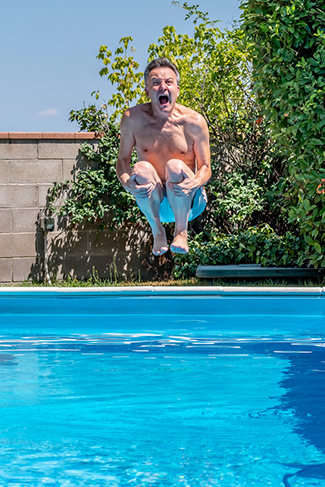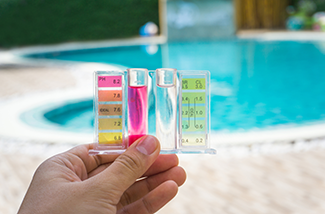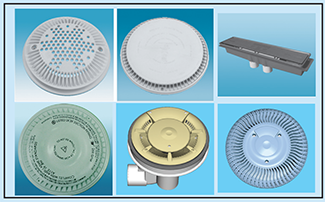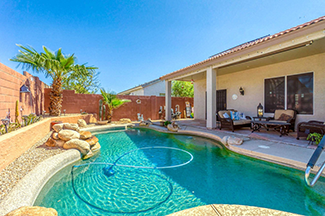Refreshing Your Pool For A Refreshing Dip In The Summer
Refreshing Your Pool For a Refreshing Dip In The Summer
When the air temperature lingers just above 90 degrees, it’s tempting to jump in the pool.
 But before you show off your best cannonball, bellyflop, or take the Nestea Plunge, get your pool in shipshape.
But before you show off your best cannonball, bellyflop, or take the Nestea Plunge, get your pool in shipshape.
Remove the Pool Cover
Don't remove the cover before you clean it off. Remove leaves, dirt, branches, dead critters, and whatever else has collected on top of it so they won't fall into the pool or onto the pool deck. Before storing it for the summer, hose it off with high pressure, let it dry, and sprinkle a little talcum powder over it to keep it from sticking to itself while it’s stored. Choose a cool, dry storage area.
Inspect the Water Level
For the pump to properly function, the water must be high enough to circulate well. The water level should reach the middle of the skimmer. If it doesn’t, add water.
Inspect & Balance the Water Chemistry
Assess the water for “total dissolved solids” like calcium. A pool with a high level of total dissolved solids will force the pump and filter to work overtime and the pool will require chemicals to keep the water sparkling. Take a sample of the pool water to your neighborhood pool supply store. They will test it for free and recommend the right chemicals.
If necessary "shock" the pool by raising the chlorine level if the pool is chlorinated. You can do this yourself with an oxidizer from your pool dealer. Choose a product compatible with your filter system. The shock will oxidize "dead" material killed by chlorine, such as bacteria, algae, and skin cells. This should be done regularly during swim season, or you can buy an ozone generator to do the job.
IMPORTANT: Do not drain and refill your pool in the summer to balance new water. The air is too hot and dry and can crack the surface. If you need to drain and refill the pool, do it between November and February. Most municipalities prohibit pool drainage down the street or alley. Check with your municipality for proper draining procedures.

If you can't get the chemistry right outside of that timeframe, call a professional pool service company to do it for you.
Add salt if your pool is salt-chlorinated. Check salt levels and clean cells regularly.
Inspect the Equipment
Be sure to inspect your equipment to ensure that it is running quietly and is leak-free. Check the concrete pad under the pump for wet spots. If you find a leak, call a repair service to fix it. It's easier to make repairs when the leaks are small.
Make sure the pump is working properly. Run the pool's circulation system for several hours. Check the filter and do a pre-season cleaning, which involves opening the filter tank and disassembling the cartridge or DE grid (the “diatomaceous earth" filter). Listen to the pump to hear if it’s running quietly and notice if there's any leaking water around it.
Consult with a professional pool technician about replacing your single-speed pump with an energy-efficient variable-speed pump. Per ARS 44-1375.02, Section B., the law requires that only variable speed pumps are to be installed when replacing a current one. This type operates much more efficiently and provides a great ROI on your electric bill. They are also much quieter.

Note the filter pressure when the water is clean and balanced. Clean the filter when the pressure rises by 10. For example, if the pool is clean at 15 psi, clean the filter when it reaches 25 psi.
You should also clean your filter:
- During an algae bloom treatment
- After major storms
- As part of opening or closing your pool
PRO TIP: Do not use any sort of acid dilution on a filter cartridge. Always use filter cleaner. Acid will burn the debris into the filter.
Change out the filter cartridge every one to two years or around 2,000 pump hours. Sand filter media should be replaced between five and seven years, if not sooner if the water continues to be murky after balancing and cleaning. You may need a professional to replace them.
Safety Inspection
Inspect handrails, diving boards, ladders, slides, and fountains and secure anything that’s shaky or damaged.
Make sure the fences and safety features, including the self-closing and self-latching gates, work properly. Update your list of emergency contacts. Install anti-entrapment covers on the drains in your pool and spa to meet federal requirements. Keep a well-stocked first-aid kit nearby. Fix anything that could be a trip hazard such as cracked or chipped decking.
Review pool safety rules with your family and with any neighbors whose children use your pool. Make sure the pool and spa wiring are up to code as well as all exterior GFI’s.
Refresh The Kool Deck

Clean up set-in deck stains with Kool Deck’s Commercial Cleaner. Scrub rust stains with a solution of 40 percent muriatic acid and 60 percent water (the solution should bubble). Caution: Muriatic acid is corrosive. Wear safety glasses, protective clothing, and rubber gloves when you handle it. Also, the acid will etch stone, so don’t use it on natural stone. It will also kill grass and plants near the deck surface being cleaned.
Keep It Up
Once everything is up and running, do weekly maintenance. Devote time every week to thoroughly clean the pool including removing debris, vacuuming, brushing the pool down, emptying skimmer and pump baskets, and chemically treating the water. Cleaning the filter is extremely important in summer, particularly during monsoon season when dust storms and heavy winds hit the area. One good dust storm can quickly turn a pool green if not tended to right away.
If your pets enjoy regular swims, be aware that one dog paddle session is the equivalent of having six people in the pool. You will need to clean the pool more frequently if your dog(s) go for a swim.
An automated pool cleaner can help by vacuuming the pool daily.
 If cleaning the pool weekly is not your idea of fun, hire a professional pool cleaning service. The cost of hiring a pool service can range greatly due to the size and complexity of your pool. A professional service technician will clean the pool, balance the chemicals, and routinely examine the equipment.
If cleaning the pool weekly is not your idea of fun, hire a professional pool cleaning service. The cost of hiring a pool service can range greatly due to the size and complexity of your pool. A professional service technician will clean the pool, balance the chemicals, and routinely examine the equipment.
Clean the pool deck frequently with a leaf blower or hose. Clean up spills as soon as they drop to prevent staining. Scrub acrylic or Kool Deck with soap or laundry detergent and water.
Prep for Next Season
The need to drain the pool depends on the water’s chemistry. When the swim season ends, and the temperature is regularly below 80 degrees, you can drain the pool if a pool service professional recommends it. Hire a company that will use a reverse osmosis system to sanitize and return up to 70% of the water.
While the pool is drained, hire a professional pool service to acid wash and polish the pool’s surface and tiles to remove the white, hard-water ring at the waterline. This is also a good time to replace and repair the pool’s lights. If your pool is around 10 years old, it may need resurfacing which can be done at that time.
Don't wait too long to get your pool ready for summer. Pool service companies will already be busy.
Home Maintenance To-Do | #RefreshYourPool
###
Podcast
New to Arizona? We discuss more things you should know. If you're a 'snowbird', important tips to lockup your property for the summer. Maintaining your pool from removing a cover to testing water quality and child protection fencing around it. Weekly To Do with Jon Owens of Kinetico discussing improving water quality in the home. And a homeowner has a problem with a variable speed pool pump.
Photo Credit
- Pool & Hot Tub Appliance
- Shutterstock
Related Content
- DIY FAQ: How Do I Get My Pool Ready For Summer?
- DIY FAQ: What’s The Best Chlorine-Alternative For Easy Pool Care?
- DIY FAQ: Preventing A Green, Murky Pool
- DIY FAQ: Time To Get Ready For A Big Splash Party
- Certified Partners:
